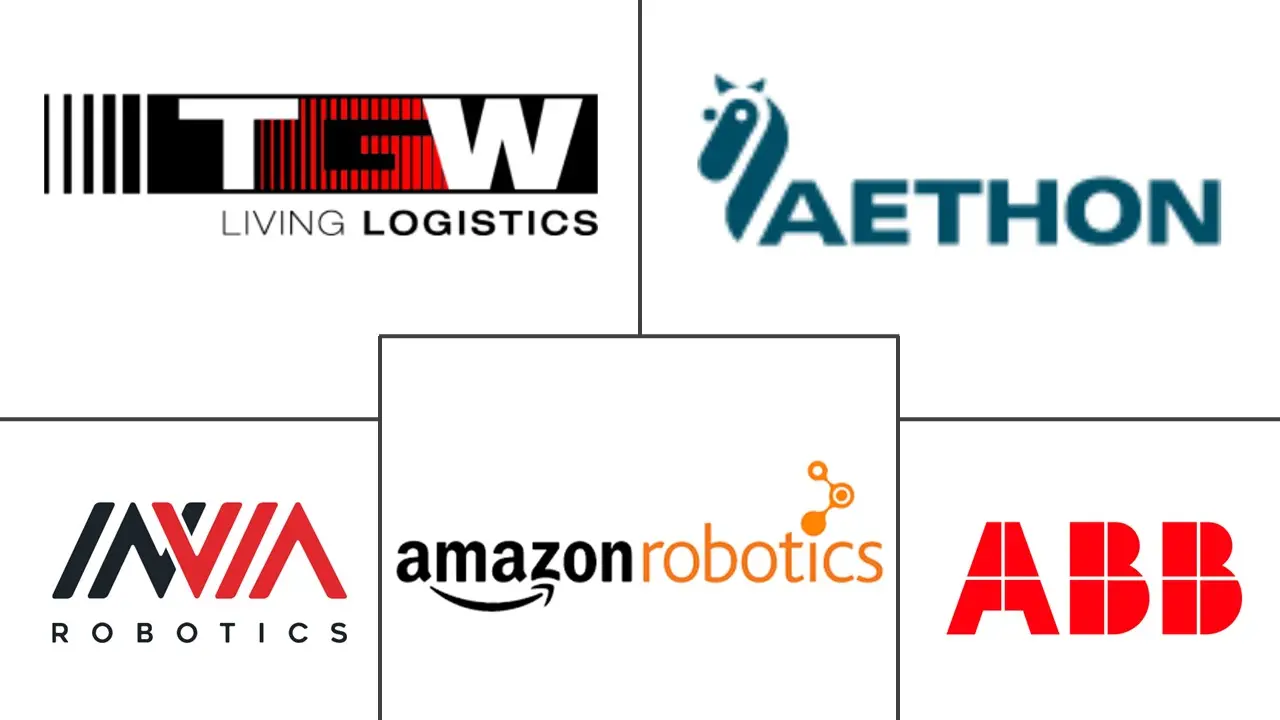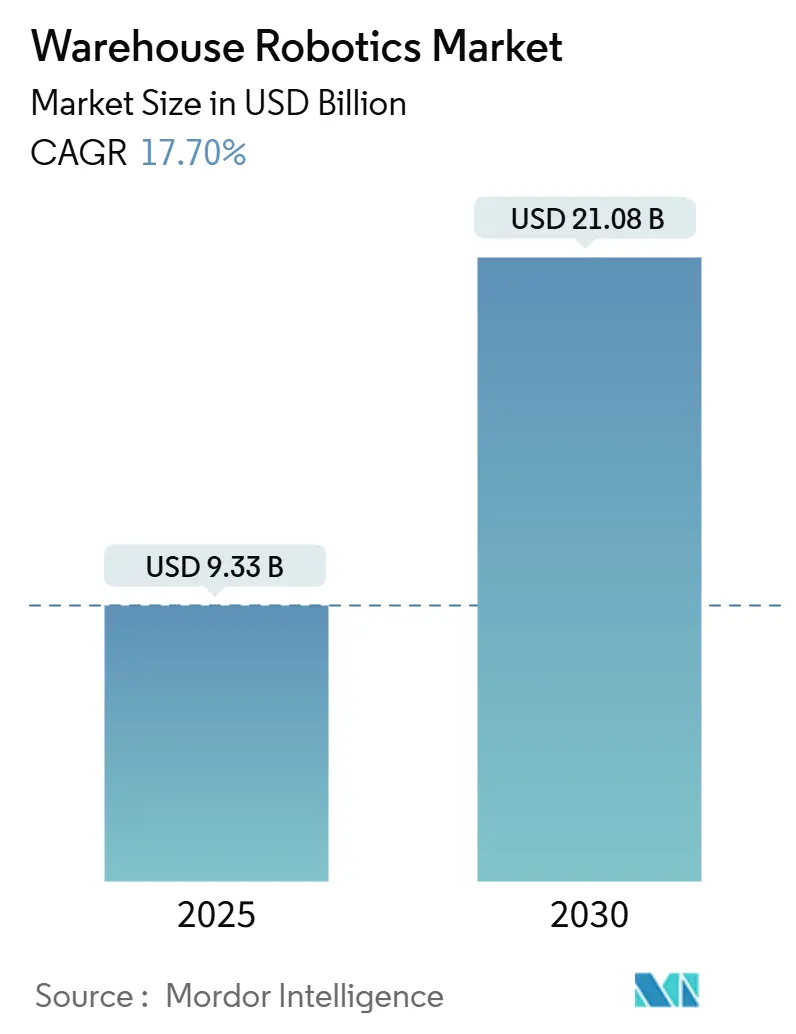
Warehouse Robotics Market Analysis by Mordor Intelligence
The warehouse robotics market size is valued at USD 9.33 billion in 2025 and is forecast to climb to USD 21.08 billion by 2030 at a 17.7% CAGR. A tight labor pool in OECD economies, SKU proliferation that complicates manual picking, and computer-vision breakthroughs that let robots grasp irregular items are the prime accelerants. Intensifying same-day-delivery promises compress fulfillment windows, driving retailers and 3PLs to automate complex picking flows with autonomous mobile robots (AMRs) and automated storage and retrieval systems (AS/RS). Asia Pacific dominates shipments as China recorded a 44% spike in new warehouse robot installations during 2024.[1]IFR Editorial Team, “Robot Installations Reach Record High in China,” International Federation of Robotics, ifr.orgHardware still accounts for 70.62% of outlays, yet edge-enabled fleet-orchestration software is the fastest-growing layer as operators seek real-time optimization that lifts asset utilization and ROI.[2]Editorial, “Tech Trends 2030: The Next Era of Industrial Robotics,” Siemens Insights, siemens.com M&A keeps reshaping the field: Zebra Technologies bought Photoneo for USD 350 million in December 2024 to secure 3-D vision IP.
Key Report Takeaways
- By product type, industrial robots led with 34.62% revenue share of the warehouse robotics market size in 2024; mobile robots are projected to expand at an 18.23% CAGR through 2030.
- By function, storage commanded 38.62% share of the warehouse robotics market size in 2024, while picking and sorting is advancing at an 18.34% CAGR through 2030.
- By component, hardware captured 70.62% of the warehouse robotics market share in 2024; software is forecast to register an 18.67% CAGR to 2030.
- By end-user industry, retail and e-commerce accounted for a 28.73% slice of the warehouse robotics market size in 2024, yet automotive shows the highest projected CAGR at 18.18% through 2030.
- By geography, Asia Pacific held 39.89% share of the warehouse robotics market size in 2024 and is set to expand at an 18.21% CAGR to 2030.
Global Warehouse Robotics Market Trends and Insights
Drivers Impact Analysis
| Driver | (~) % Impact on CAGR Forecast | Geographic Relevance | Impact Timeline |
|---|---|---|---|
| E-commerce SKU proliferation and same-day-delivery pressure | +2.8% | Global, concentrated in North America and APAC | Short term (≤ 2 years) |
| Rising investments by 3PLs and retailers in AMRs and AS/RS | +3.1% | North America and Europe, expanding to APAC | Medium term (2-4 years) |
| Shrinking warehouse labor pool in OECD economies | +2.4% | North America and Europe core, spillover to developed APAC | Long term (≥ 4 years) |
| AI-powered vision enabling robotic picking of difficult SKUs | +1.9% | Global, early adoption in North America and Europe | Medium term (2-4 years) |
| Edge-based fleet orchestration cuts downtime and boosts ROI | +1.6% | Global, technology-forward markets first | Short term (≤ 2 years) |
| Carbon-neutral warehousing mandates favor low-energy robots | +1.2% | Europe and North America, expanding globally | Long term (≥ 4 years) |
| Source: Mordor Intelligence | |||
E-commerce SKU Proliferation and Same-Day-Delivery Pressure
Amazon now juggles more than 350 million active SKUs, a scale that overwhelms manual pickers and demands robotic confidence in grasping dissimilar shapes. Same-day commitments shrink cycle times to under four hours in major metros, so fulfillment nodes deploy AMRs that triple order-processing speed during peak events. Seasonal spikes can push volumes 500%, rendering manual flex-labor models cost-prohibitive. Goods-to-person systems erase unproductive employee travel, while AI inventory-placement tools cut average pick paths 60%. Regulators enforce truthful delivery-promise disclosure, compelling operators to harden throughput guarantees with robotic capacity.
Rising Investments by 3PLs and Retailers in AMRs and AS/RS
DSV earmarked USD 50 million to roll out AMRs across European sites, unlocking density gains of 85% and shielding margins from urban rent inflation. Walmart matched with a USD 1 billion automation pledge that widens adoption of micro-fulfillment centers embedded in existing stores.[3]Staff Writer, “Walmart Announces USD 1 Billion Investment in Supply Chain Automation,” Walmart Corporate News, walmart.com Robots-as-a-service schemes lower entry thresholds by shifting spend from CAPEX to variable fees per pick. ISO 3691-4 driverless-truck standards give risk-averse logistics managers a compliance roadmap, accelerating green-lighting of AMR pilot projects.
Shrinking Warehouse Labor Pool in OECD Economies
Vacancy rates top 8% in U.S. and European fulfillment hubs, and churn hovers near 100% in strenuous roles. Real wages escalated 15-20% during 2024, eroding profit cushions for manual warehouses. Robots slash labor minutes per order up to 60%, enabling facilities to absorb volume growth without proportionate head-count increases. Aging workforces further tighten supply in Japan and Germany, while younger cohorts prefer technology-centric jobs. Firms now position robotics as augmentation rather than displacement, reserving human staff for exception resolution and continuous improvement tasks.
AI-Powered Vision Enabling Robotic Picking of Difficult SKUs
Vision stacks now hit 99.5% grasp accuracy on transparent, deformable, or reflective items that once defeated automation. Machine-learning pipelines accelerate category onboarding from weeks to hours, broadening addressable use cases in pharma and luxury cosmetics. New multi-material grippers combine suction, pinch, and soft-finger modes in one end-effector, letting a single cell tackle 15-20 SKU families without retooling. Edge GPUs compress image-to-action latency below 50 milliseconds, rivaling human reflex while maintaining repeatability.
Restraints Impact Analysis
| Restraint | (~) % Impact on CAGR Forecast | Geographic Relevance | Impact Timeline |
|---|---|---|---|
| High CAPEX and integration cost for brownfield retrofits | -1.8% | Global, more acute in mature markets with legacy infrastructure | Short term (≤ 2 years) |
| Fragmented safety and data-privacy regulations by region | -1.4% | Global, particularly complex in Europe and North America | Medium term (2-4 years) |
| Cyber-physical security vulnerabilities in fleet software | -0.9% | Global, higher risk in connected environments | Short term (≤ 2 years) |
| Lithium-ion battery supply volatility affects AMR BOM costs | -0.7% | Global, supply chain concentrated in APAC | Medium term (2-4 years) |
| Source: Mordor Intelligence | |||
High CAPEX and Integration Cost for Brownfield Retrofits
Retrofitting legacy sites costs 60-80% more than greenfield builds because aisles, mezzanines, and electrical services rarely align with robot envelopes.[4]Bastian Solutions Team, “Warehouse Automation: Brownfield vs Greenfield Considerations,” Bastian Solutions, bastiansolutions.com Projects often trigger USD 2 million in wiring, floor leveling, and software-interface expenses. Every week of installation downtime can forfeit USD 50,000 in throughput revenue, so operators stagger rollouts in micro-phases that preserve live lanes. Vendors now push modular pods that fit inside existing racks, trimming upfront cash burn and easing board-level approvals.
Fragmented Safety and Data-Privacy Regulations by Region
ISO 10218:2025 mandates new power-and-force-limiting thresholds, while U.S. ANSI/RIA R15.08 diverges on navigation safeguards, forcing global shippers to certify one fleet twice. GDPR rules oblige European warehouses to justify every sensor pixel captured near staff, adding legal review cycles to deployment timelines. Documentation hurdles raise program costs 15-25% and can extend launch by six months as firms reconcile overlapping standards.
Segment Analysis
By Type: Mobile Robots Drive Flexible Automation
Mobile platforms edge forward with an 18.23% CAGR to 2030, eclipsing fixed industrial units for greenfield fulfillment projects. The warehouse robotics market size for mobile robots is projected to reach USD 9.8 billion by 2030 as retailers value layout agility that supports frequent SKU resets. Industrial six-axis arms still own heavy palletizing with 34.62% share, yet conveyor-less AMR strategies cut infrastructure costs 70% and shrink commissioning times from months to weeks. Parcel hubs favor high-speed sortation systems that already handle 40% more packages than pre-2024 baselines, while cube-based AS/RS lifts storage density fourfold in urban footprints. Integration layers now orchestrate mobile fleets, shuttles, and lifts under one scheduler to prevent aisle congestion and balance work queues.
The warehouse robotics market continues to showcase hybrid deployments where AMRs ferry totes to stationary arm clusters for high-dexterity picks. AI route engines re-plan paths every second to dodge obstacles and reduce robot idle to under 10%. Vendors position large-format floor AMRs for case movement and compact swarm bots for goods-to-person tasks, maximizing cube utilization. Industrial palletizers gain embedded vision that trims pattern design times 25% and improves load stability, vital for fragile EV battery packs. Collectively, multi-modal fleets future-proof operations against product-mix volatility.
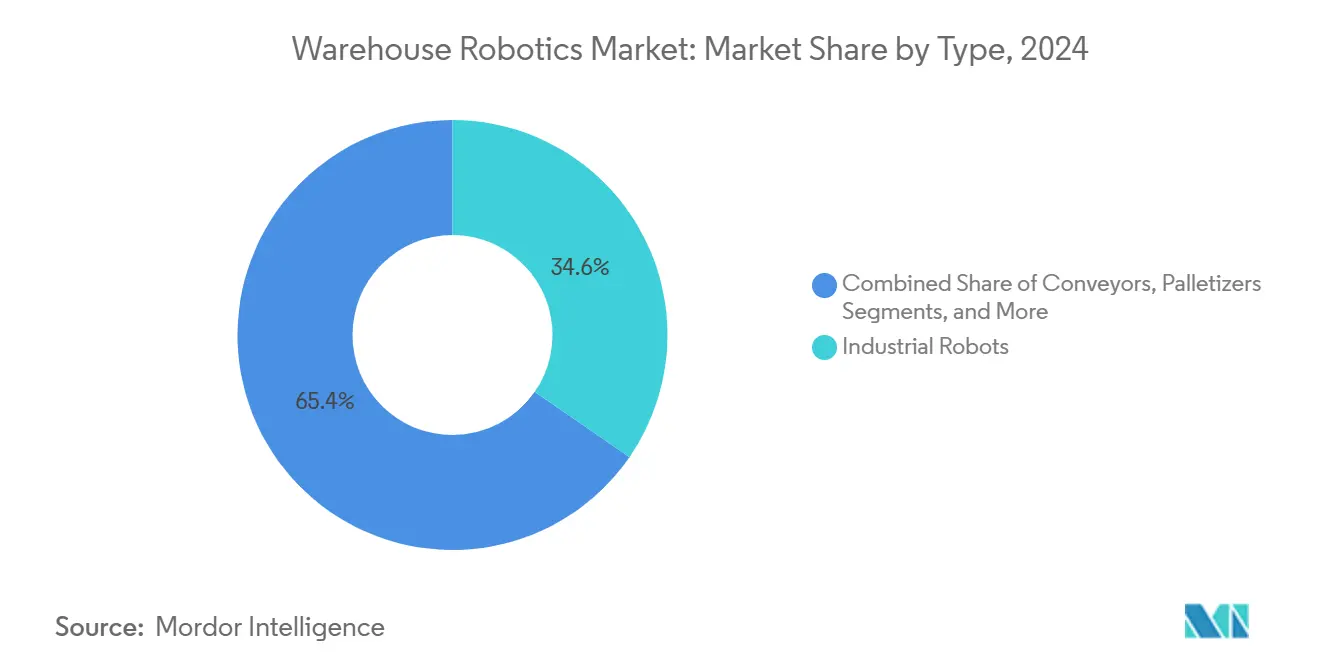
Note: Segment shares of all individual segments available upon report purchase
By Function: Picking Dynamics Redefine Storage Norms
Storage still dominates with 38.62% slice of 2024 revenue, yet picking and sorting drives incremental value and will post an 18.34% CAGR to 2030. The warehouse robotics market share for advanced picking systems rises as goods-to-person principles cut worker walk distances 75%. Dynamic slotting algorithms reposition inventory overnight based on forecast demand, shrinking average pick span to 30 seconds. Edge latency now measures below 30 milliseconds, letting robots recalculate optimal routes mid-mission. Cross-dock nodes invest in robotic sorters that process e-commerce returns and re-inject goods into outbound flows the same day, limiting markdown erosion.
Predictive analytics tie demand data to AS/RS shuttle assignments, pushing high-velocity SKUs near ergonomic pick stations and lowering daily cycle-count labor. Robotics packaging cells adapt box size in real time, cutting corrugate waste 15% and optimizing truck fill rates. Split-case automation gains traction in grocery fulfillment where variable weight items challenge conveyor pacing. Operators view picking performance as the rate-limiting step, and capital therefore gravitates toward vision-equipped end-effectors and autonomous carts that close the gap.
By Component: Software Orchestration Becomes the Differentiator
Hardware claimed 70.62% of spending in 2024, but software revenues will outpace all other layers at an 18.67% CAGR through 2030. Operators realize that without intelligent orchestration, hardware utilization stalls at 60-65%. Unified control towers now issue fleet-wide missions, predict maintenance intervals, and harmonize traffic across brands. This flexibility prevents vendor lock-in by ensuring new robot models plug into common APIs. Predictive algorithms avert 40% of unexpected stoppages, extending asset life and boosting return on invested capital.
The warehouse robotics market size linked to software subscriptions is projected to surpass USD 4 billion by 2030 as robotics-as-a-service converts upfront licenses into monthly fees that scale with activity. Managed services bundles fold in 24/7 remote monitoring, on-site spares, and process-optimization sprints, letting lean organizations stay current without expanding head-count. Cloud visibility across multi-site networks supports cross-dock balancing, so under-utilized robots in one facility shift tasks to hotspots at another, squeezing additional capacity from existing fleets.
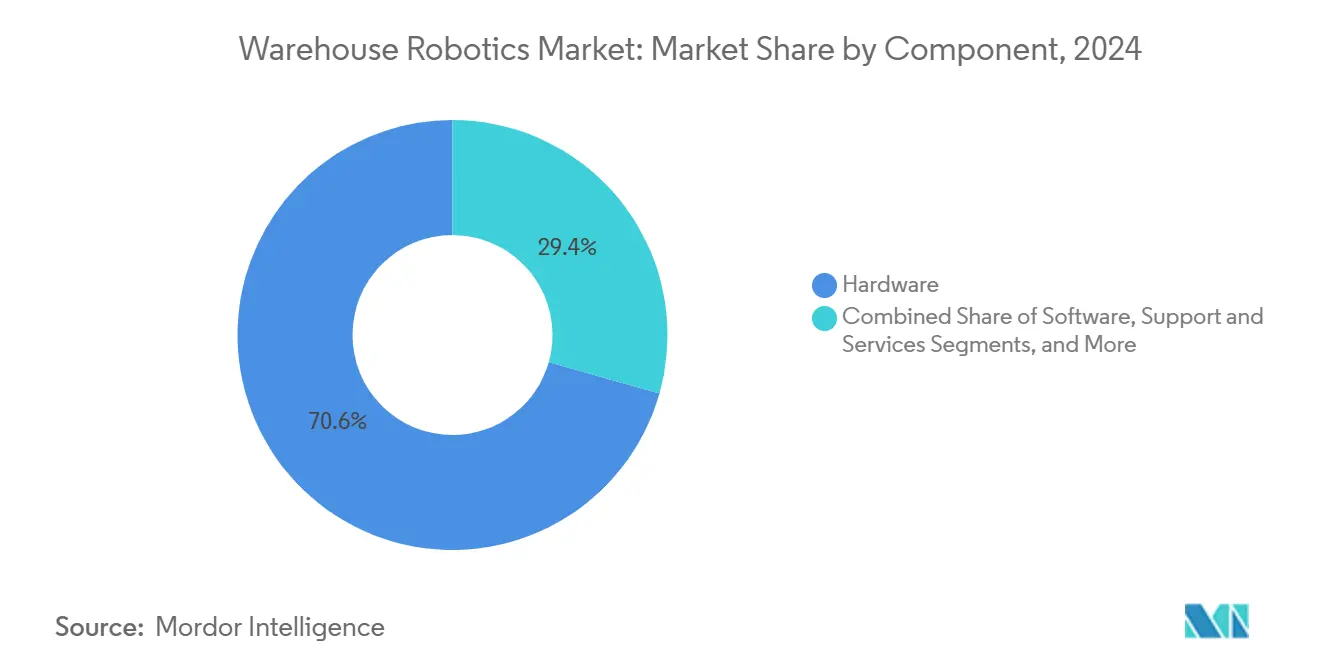
Note: Segment shares of all individual segments available upon report purchase
By End-User Industry: Automotive Challenges Retail Supremacy
Retail and e-commerce remained the biggest buyers in 2024 at 28.73%, but electrified-vehicle programs propel automotive to the fastest 18.18% CAGR. Lithium-ion battery packs require careful orientation and weight balancing, making robotic handling essential for safety and takt-time adherence. The warehouse robotics market size earmarked for automotive spares is forecast to breach USD 3 billion by 2030, bolstered by integrated manufacturing-to-warehouse control loops that automate just-in-time sequencing.
Food and beverage operators automate chilled zones, trimming energy usage 30% as robots move goods in narrow aisles that humans find uncomfortable. Pharma facilities extend robotics into serialization and tamper-evident packaging to obey stringent traceability mandates. Third-party logistics providers embed multi-tenant AMR fleets to guarantee 99.9% pick accuracy, a service-level edge in a commoditized sector. Electronics assemblers rely on ESD-safe grippers and clean-room-rated drives, underscoring niche growth opportunities for specialist vendors.
Geography Analysis
Asia Pacific retained 39.89% of global revenue in 2024 and is tracking an 18.21% CAGR to 2030 as Chinese makers export aggressively and regional wages climb. Local champions such as Geek+ shipped record volumes while Japan turned to robotics to offset an aging workforce and South Korea integrated AS/RS with smart factories under national industrial policy. India enters an acceleration phase on the back of government-backed automation subsidies that attract foreign direct investment.
North America ranks second and remains a bellwether for venture-backed innovation, channeling more than USD 2 billion into warehouse automation startups during 2024. U.S. big-box retailers pioneer micro-fulfillment and dark-store concepts, while Canada’s Toronto-Vancouver corridor scales robotics to relieve labor scarcity. Mexico benefits from near-shoring and deploys AMR-ready warehouses that cut landed costs for U.S. importers by 25%.
Europe lags headline growth yet maintains steady adoption. Germany leans on Industry 4.0 grants to fund integrated logistics cells for automotive suppliers. The United Kingdom prioritizes flexible systems that can realign to post-Brexit customs flows. France and the Netherlands act as pan-European gateways, investing in cube-storage to mitigate land constraints. The EU’s forthcoming AI Act will raise compliance costs yet elevate safety baselines, favoring established vendors with proven records.
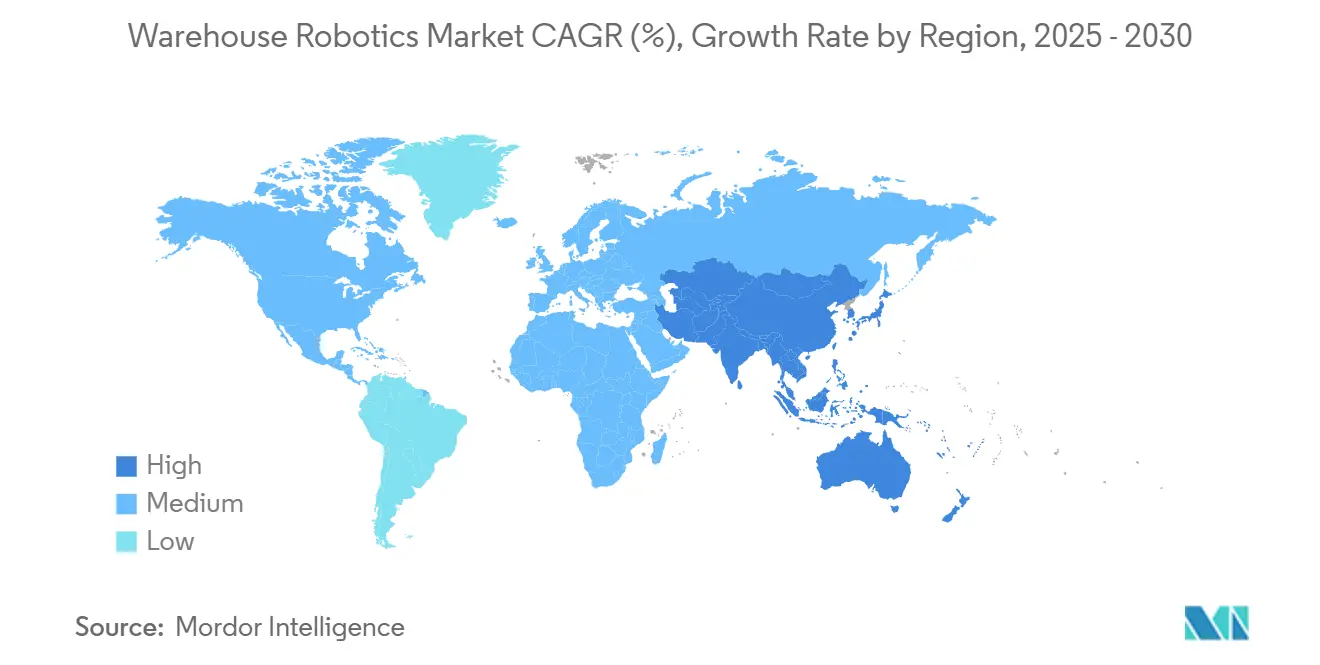
Competitive Landscape
More than 700 active suppliers keep margins tight, but consolidation is gathering pace. Amazon Robotics, Dematic, and Swisslog command entrenched footprints with broad portfolios, while innovators like Symbotic and Exotec win share by offering modular, high-throughput architectures. Zebra’s USD 350 million Photoneo buy embeds proprietary 3-D vision into scanners and lifts perceived differentiation. Symbotic’s purchase of Walmart’s internal robotics arm in January 2025 grants proprietary sortation IP and an anchor retail customer.
Technology head-to-head contests now pivot on AI path planning, latency control, and interoperability. Vendors pairing proprietary hardware with open APIs gain mindshare as operators mix brands inside single facilities. Robotics-as-a-service contracts give mid-tier players a financial edge, transferring ownership risk away from customers. White-space niches such as cold storage and hazardous goods remain ripe for entrants that can certify specialized payloads. Competitive intensity will continue, yet capital access and software stacks are emerging as the decisive victory levers.
Warehouse Robotics Industry Leaders
-
Kiva Systems (Amazon Robotics LLC)
-
TGW Logistics Group GMBH
-
Singapore Technologies Engineering Ltd (Aethon Incorporation)
-
InVia Robotics Inc.
-
ABB Ltd.
- *Disclaimer: Major Players sorted in no particular order
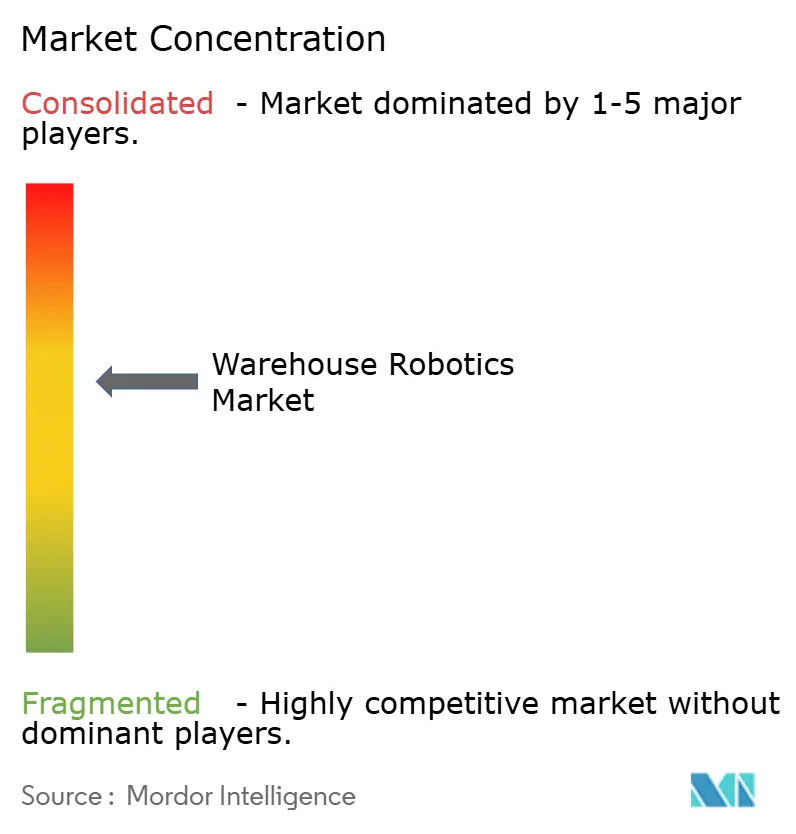
Recent Industry Developments
- September 2025: Dyna Robotics secured USD 120 million in Series B funding led by Nvidia and Amazon, accelerating AI-driven manipulation systems.
- July 2025: Amazon deployed its one-millionth robot worldwide and unveiled a generative AI model for warehouse optimization.
- May 2025: DHL Group signed an MoU with Boston Dynamics for 1,000 Stretch robots across European and North American centers.
- May 2025: AutoStore posted record quarterly revenue of USD 185 million and announced a new Ohio manufacturing site plus next-gen Black Line robots.
Global Warehouse Robotics Market Report Scope
Warehouse robotics refers to machines capable of performing specific tasks within a warehouse, to relieve human workers from repetitive and potentially dangerous tasks. The surge in online shopping has led to an exponential increase in demand for robots in warehouse space. These Robots are equipped with advanced AI and automation technologies, which play a pivotal role in streamlining order fulfillment processes, optimizing inventory management, and ensuring swift delivery of cards.
The warehouse robotics market is segmented by type (industrial robots, sortation systems, conveyors, palletizers, automated storage and retrieval system (ASRS), mobile robots (AGVs and AMRs)), by function (storage, packaging, trans-shipment, other functions), by end-user industry (food and beverage, automotive, retail, electrical and electronics, pharmaceutical, other end-user industries) and by geography (North America [United States, Canada], Europe [United Kingdom, Germany, France, Rest of Europe], Asia-Pacific [China, South Korea, Japan, Rest of Asia-Pacific], Latin America, Middle-East and Africa). The market sizes and forecasts are provided in terms of value USD for all the above segments.
| Industrial Robots |
| Sortation Systems |
| Conveyors |
| Palletizers |
| Automated Storage and Retrieval Systems (AS/RS) |
| Mobile Robots (AGVs and AMRs) |
| Storage |
| Packaging |
| Trans-shipment |
| Picking and Sorting |
| Hardware |
| Software |
| Support and Services |
| Food and Beverage |
| Automotive |
| Retail and E-commerce |
| Electrical and Electronics |
| Pharmaceutical |
| Third-Party Logistics (3PL) |
| Other End-user Industries |
| North America | United States | |
| Canada | ||
| South America | Brazil | |
| Argentina | ||
| Rest of South America | ||
| Europe | Germany | |
| United Kingdom | ||
| France | ||
| Italy | ||
| Rest of Europe | ||
| Asia-Pacific | China | |
| Japan | ||
| South Korea | ||
| India | ||
| Rest of Asia-Pacific | ||
| Middle East and Africa | Middle East | Saudi Arabia |
| United Arab Emirates | ||
| Turkey | ||
| Rest of Middle East | ||
| Africa | South Africa | |
| Nigeria | ||
| Rest of Africa | ||
| By Type | Industrial Robots | ||
| Sortation Systems | |||
| Conveyors | |||
| Palletizers | |||
| Automated Storage and Retrieval Systems (AS/RS) | |||
| Mobile Robots (AGVs and AMRs) | |||
| By Function | Storage | ||
| Packaging | |||
| Trans-shipment | |||
| Picking and Sorting | |||
| By Component | Hardware | ||
| Software | |||
| Support and Services | |||
| By End-user Industry | Food and Beverage | ||
| Automotive | |||
| Retail and E-commerce | |||
| Electrical and Electronics | |||
| Pharmaceutical | |||
| Third-Party Logistics (3PL) | |||
| Other End-user Industries | |||
| By Geography | North America | United States | |
| Canada | |||
| South America | Brazil | ||
| Argentina | |||
| Rest of South America | |||
| Europe | Germany | ||
| United Kingdom | |||
| France | |||
| Italy | |||
| Rest of Europe | |||
| Asia-Pacific | China | ||
| Japan | |||
| South Korea | |||
| India | |||
| Rest of Asia-Pacific | |||
| Middle East and Africa | Middle East | Saudi Arabia | |
| United Arab Emirates | |||
| Turkey | |||
| Rest of Middle East | |||
| Africa | South Africa | ||
| Nigeria | |||
| Rest of Africa | |||
Key Questions Answered in the Report
What is the current value of the warehouse robotics market?
The warehouse robotics market is valued at USD 9.33 billion in 2025.
How fast is the warehouse robotics sector growing?
It is projected to post a 17.7% CAGR, reaching USD 21.08 billion by 2030.
Which geographic region commands the largest share?
Asia Pacific leads with 39.89% revenue share, buoyed by China’s rapid robot adoption.
Which robot type is expanding the quickest?
Mobile robots, including AGVs and AMRs, are advancing at an 18.23% CAGR through 2030.
Which end-user segment is gaining ground fastest?
Automotive logistics shows the highest growth at an 18.18% CAGR due to EV battery handling needs.
Page last updated on:
